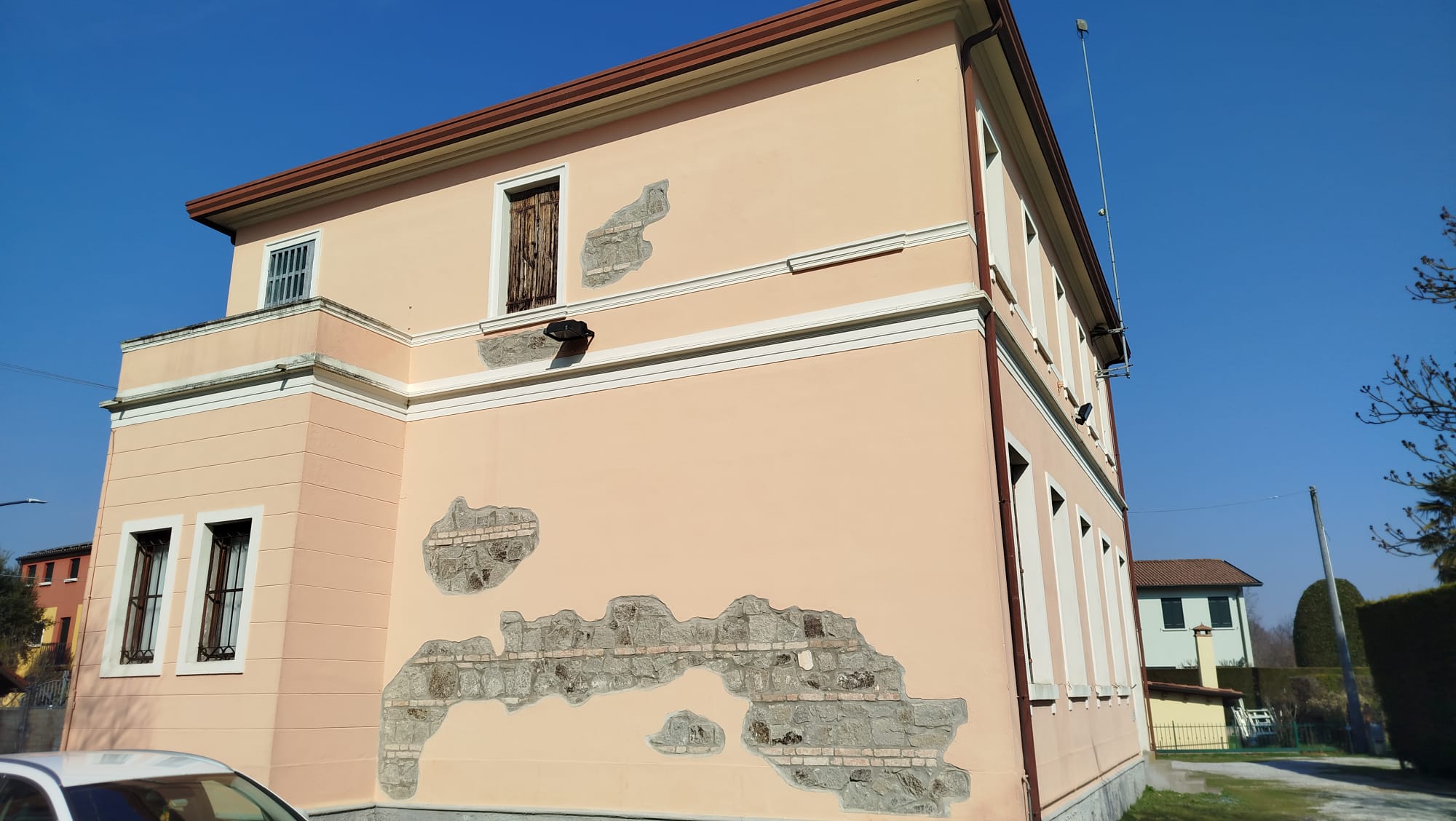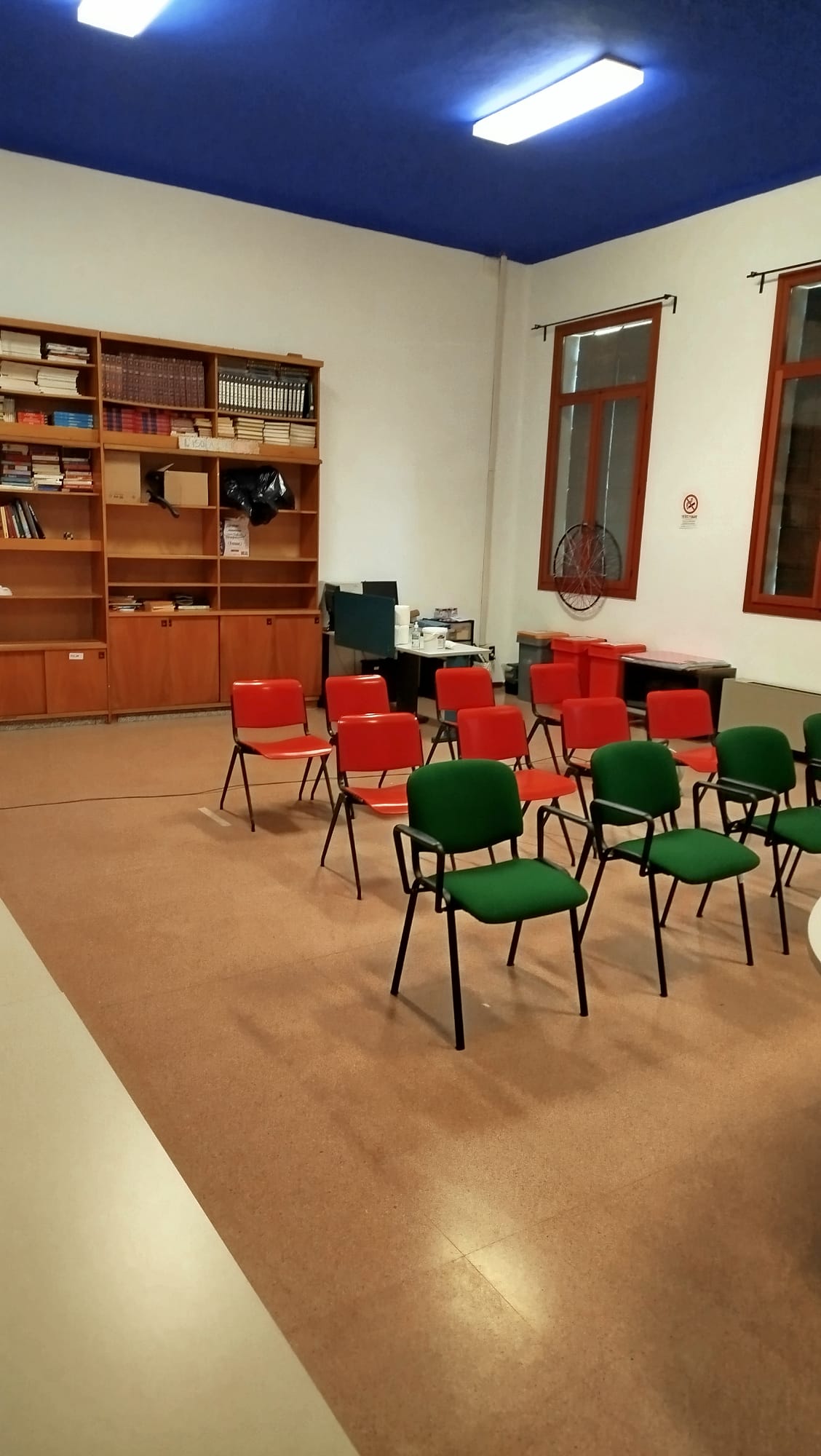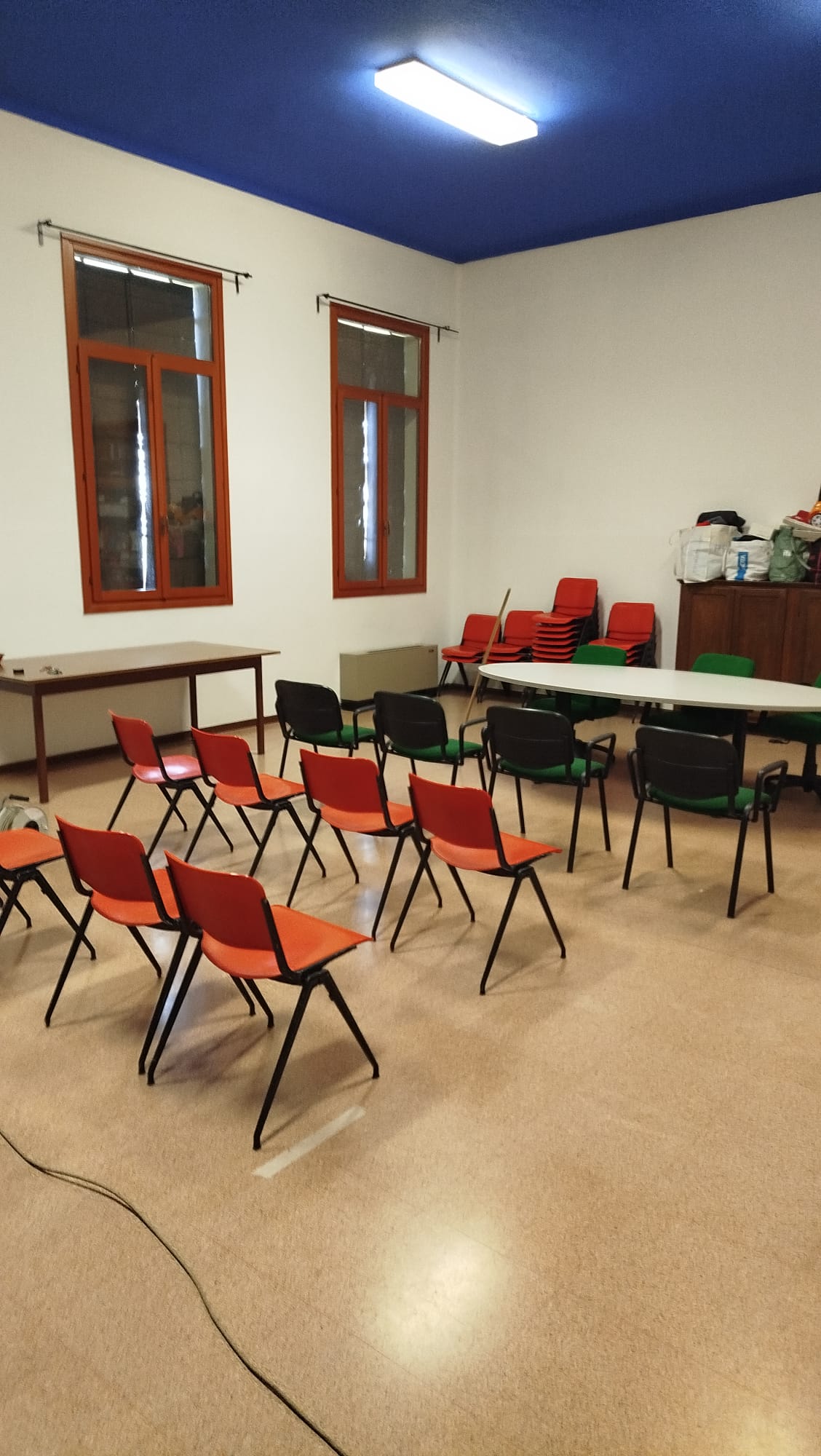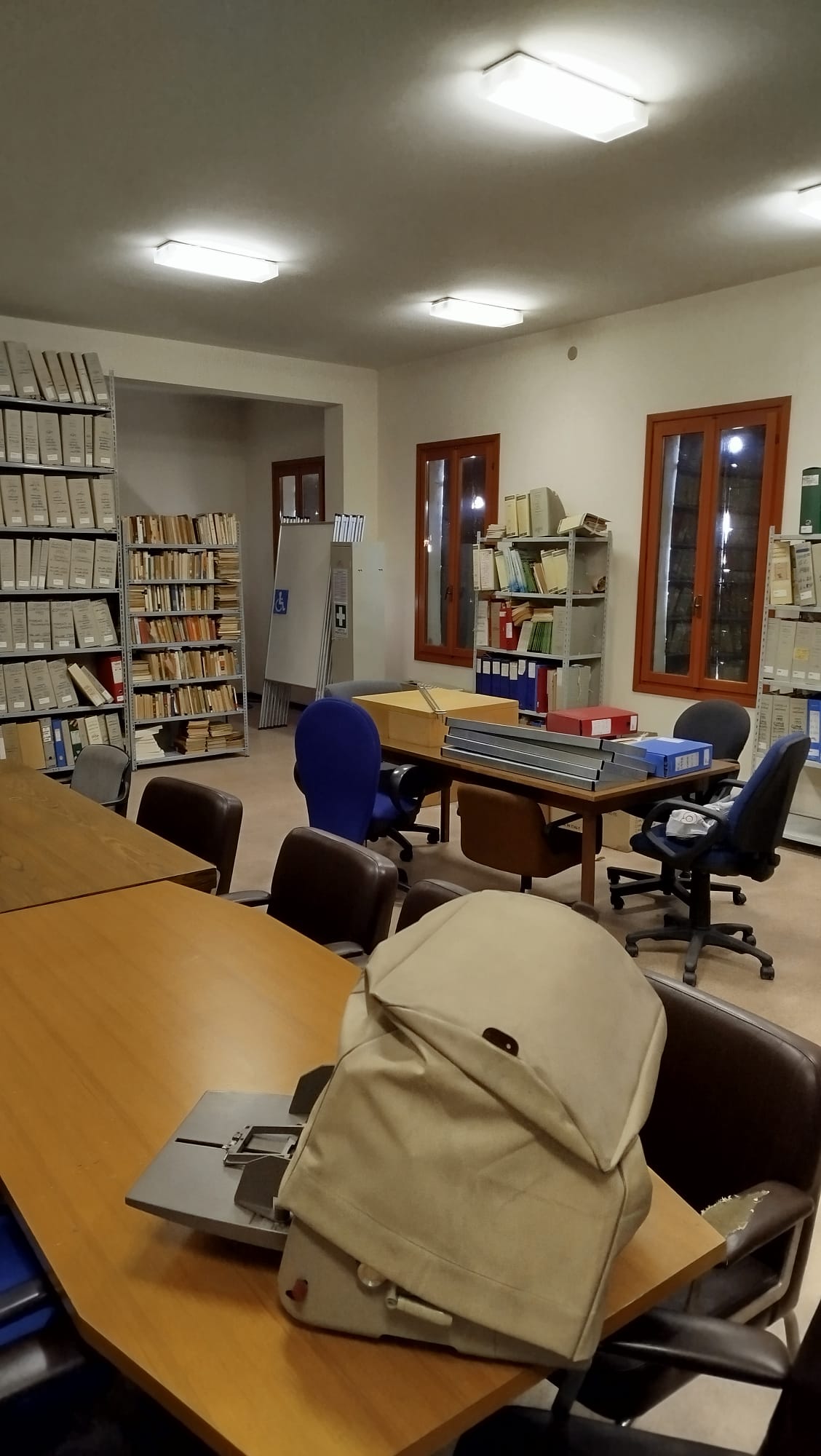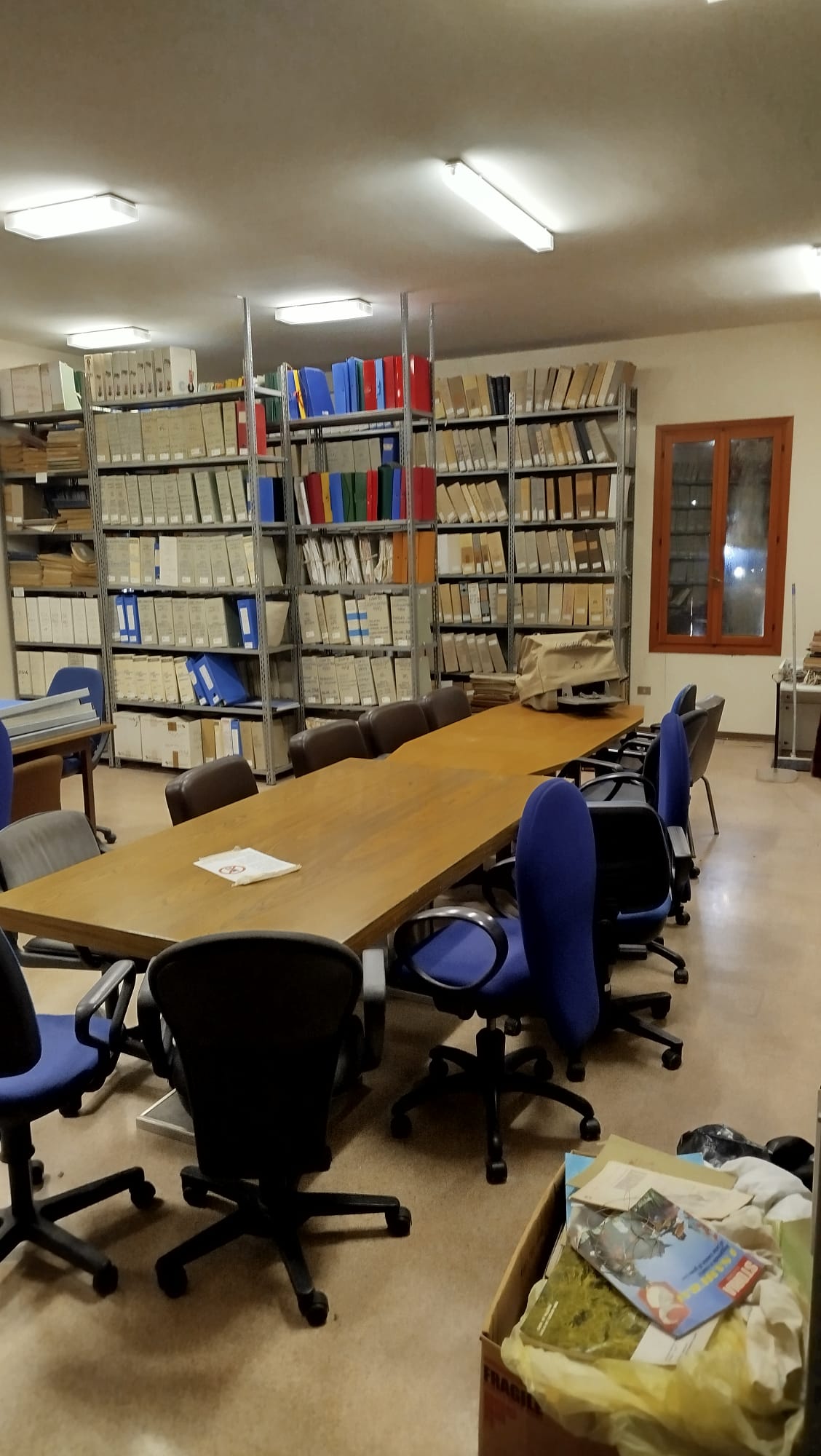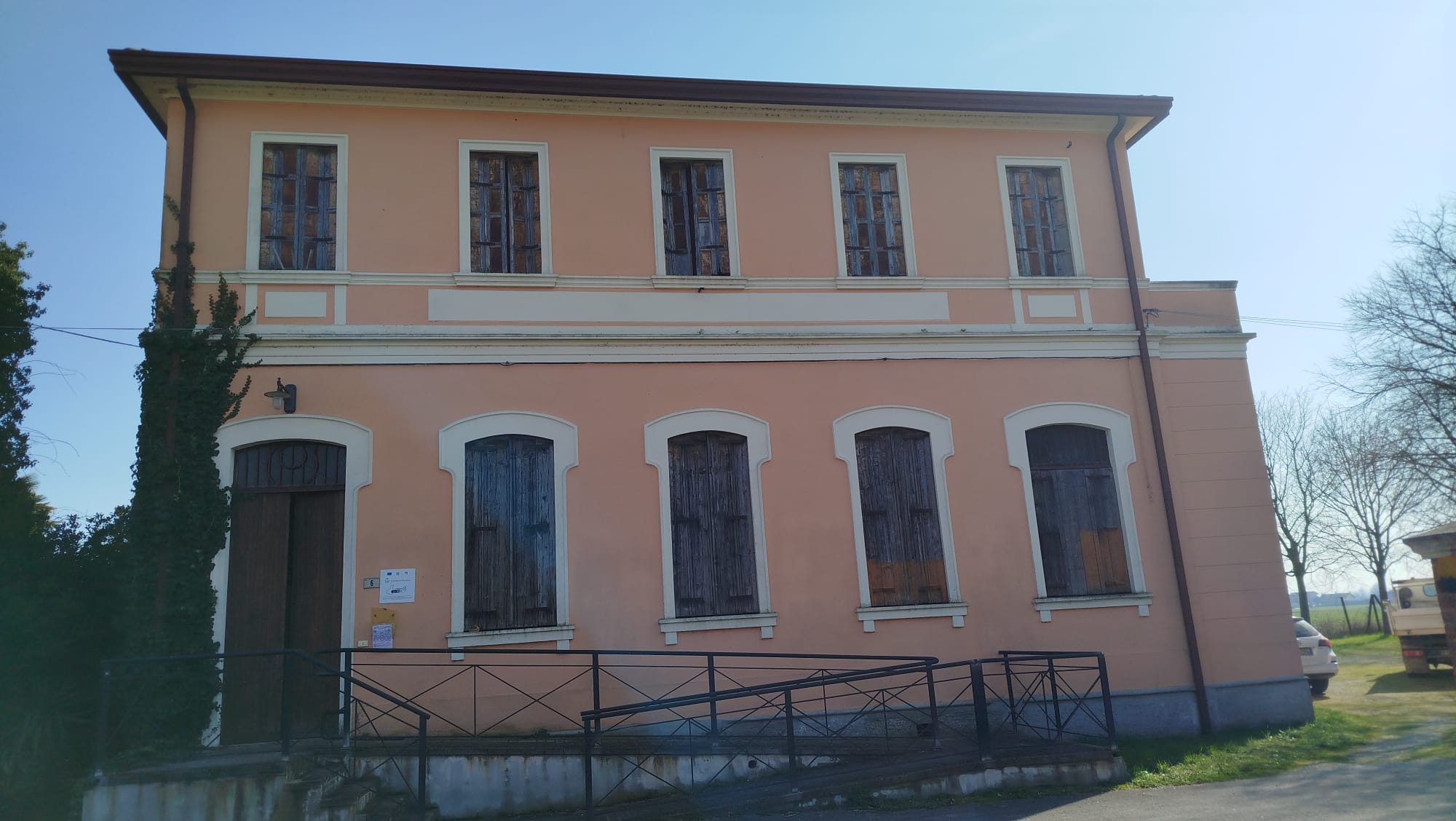Recovery of the Isola dell'Abba Civic Ce
Architectural recovery and energy efficiency of the Civic Center of Isola dell'Abba, hamlet
Renovation of the Civic Center located in the hamlet of Isola dell'Abbà for the conservation of cultural heritage
Italy
via Giuseppe Verdi, 35020 Polverara Padua
Prototype level
Yes
Yes
No
No
No
028066: Polverara (IT)
General objective:
Contribute to the transition towards a more sustainable and inclusive development model, in line with the principles of the New European Bauhaus, through the energy and functional redevelopment of the Civic Center of Isola dell'Abba. The objective is to transform the civic center into a multifunctional space, with low environmental impact, welcoming and open to the community, which promotes participation, social inclusion and quality of life.
Target groups:
The initiative is mainly aimed at:
Residents of Isola dell'Abba and the Municipality of Polverara: who will be able to benefit from a renovated, more comfortable and functional public space for social, cultural and recreational activities.
Local associations: which will be able to use the civic center for their activities and initiatives.
Third sector: which will be able to find a place in the civic center to develop social inclusion and sustainability promotion projects.
Municipal administration: which will see a publicly owned property enhanced and will be able to offer better services to the community.
Specific objectives:
Reduce energy consumption in the civic center through the replacement of fixtures, the installation of a heat pump and a photovoltaic system.
Increase comfort and functionality: Make interior spaces more welcoming and functional for the different activities that take place there.
Promote sustainability: Use materials and technologies with low environmental impact, raise community awareness of the importance of sustainability and the use of renewable sources.
Promote social inclusion: Create a space open and accessible to all, which promotes participation and social integration.
Enhance local heritage: Integrate redevelopment interventions with design and furnishing elements that enhance the identity and history of the place.
Expected results:s
Reduction of energy consumption: A reduction in the civic center's energy consumption of at least 40% i
Contribute to the transition towards a more sustainable and inclusive development model, in line with the principles of the New European Bauhaus, through the energy and functional redevelopment of the Civic Center of Isola dell'Abba. The objective is to transform the civic center into a multifunctional space, with low environmental impact, welcoming and open to the community, which promotes participation, social inclusion and quality of life.
Target groups:
The initiative is mainly aimed at:
Residents of Isola dell'Abba and the Municipality of Polverara: who will be able to benefit from a renovated, more comfortable and functional public space for social, cultural and recreational activities.
Local associations: which will be able to use the civic center for their activities and initiatives.
Third sector: which will be able to find a place in the civic center to develop social inclusion and sustainability promotion projects.
Municipal administration: which will see a publicly owned property enhanced and will be able to offer better services to the community.
Specific objectives:
Reduce energy consumption in the civic center through the replacement of fixtures, the installation of a heat pump and a photovoltaic system.
Increase comfort and functionality: Make interior spaces more welcoming and functional for the different activities that take place there.
Promote sustainability: Use materials and technologies with low environmental impact, raise community awareness of the importance of sustainability and the use of renewable sources.
Promote social inclusion: Create a space open and accessible to all, which promotes participation and social integration.
Enhance local heritage: Integrate redevelopment interventions with design and furnishing elements that enhance the identity and history of the place.
Expected results:s
Reduction of energy consumption: A reduction in the civic center's energy consumption of at least 40% i
Redevelopment
Sustainability
Community
Energy
Innovation
The redevelopment of the Isola dell'Abba Civic Center aims to improve sustainability through multiple strategies. Energy consumption and greenhouse gas emissions will be reduced by insulating the building, replacing wooden window frames with high-performance ones, installing a high-efficiency heat pump for heating and domestic hot water production, and integrating a photovoltaic system to generate electricity from renewable sources. These interventions are expected to lower the civic center’s energy consumption by at least 40% and significantly cut CO₂ emissions. The use of renewable sources will be promoted through the installation of a photovoltaic system capable of covering a significant portion of the building’s energy needs, reducing dependence on fossil fuels and contributing to clean energy production.
nvironmental comfort will be enhanced by improving thermal insulation and installing an efficient heating system, ensuring a stable and comfortable indoor climate throughout the year. This will create a more welcoming space for users, with positive effects on health and well-being. Additionally, the project includes awareness and education initiatives to engage the community on sustainability, energy efficiency, and the benefits of renewable energy sources. These activities will encourage citizens to adopt more sustainable behaviors in their daily lives.
This initiative serves as a model for integrating energy efficiency, renewable energy, and environmental comfort in public building renovation. Its comprehensive approach, which combines building envelope improvements, efficient heating systems, and renewable energy, can be replicated in other contexts, promoting a broader shift toward sustainability in line with the objectives of the New European Bauhaus. Furthermore, the active involvement of the community ensures that the transition to sustainability is inclusive and participatory, setting an example for similar initiatives elsewhere.
nvironmental comfort will be enhanced by improving thermal insulation and installing an efficient heating system, ensuring a stable and comfortable indoor climate throughout the year. This will create a more welcoming space for users, with positive effects on health and well-being. Additionally, the project includes awareness and education initiatives to engage the community on sustainability, energy efficiency, and the benefits of renewable energy sources. These activities will encourage citizens to adopt more sustainable behaviors in their daily lives.
This initiative serves as a model for integrating energy efficiency, renewable energy, and environmental comfort in public building renovation. Its comprehensive approach, which combines building envelope improvements, efficient heating systems, and renewable energy, can be replicated in other contexts, promoting a broader shift toward sustainability in line with the objectives of the New European Bauhaus. Furthermore, the active involvement of the community ensures that the transition to sustainability is inclusive and participatory, setting an example for similar initiatives elsewhere.
The redevelopment of the Isola dell'Abba Civic Center aims to enhance its aesthetic appeal while improving the quality of experience for the community. The project focuses on preserving and enhancing the existing architecture through careful material selection, color coordination, and strategic lighting. Design elements inspired by the history and identity of the area will be integrated to create a harmonious and welcoming environment, making the building not only more functional but also capable of evoking positive emotions and contributing to the overall urban renewal.
The initiative prioritizes user experience by ensuring that both indoor and outdoor spaces are functional, comfortable, and accessible to all. Enhancements in lighting, acoustics, and ventilation will improve the overall ambiance, while the addition of green areas and social spaces will foster interaction and well-being. These improvements will encourage a deeper sense of belonging and increase participation in the activities offered at the center.
A key aspect of the project is the promotion of local culture and identity. Artistic and cultural elements will be incorporated into the redevelopment, such as exhibitions of local artwork, cultural events, and the valorization of historical and architectural heritage. This approach will transform the civic center into a cultural and social hub, strengthening community ties and providing a space for shared experiences and cultural celebrations.
This initiative sets an example of how redevelopment can merge aesthetics, functionality, and cultural enrichment. By prioritizing user experience, environmental comfort, and artistic expression, the project can inspire similar interventions in other communities. Additionally, it demonstrates how public building renovations can reinforce local identity, promote cultural heritage, and align with the principles of the New European Bauhaus, making sustainability and design an inclusive and participatory process.
The initiative prioritizes user experience by ensuring that both indoor and outdoor spaces are functional, comfortable, and accessible to all. Enhancements in lighting, acoustics, and ventilation will improve the overall ambiance, while the addition of green areas and social spaces will foster interaction and well-being. These improvements will encourage a deeper sense of belonging and increase participation in the activities offered at the center.
A key aspect of the project is the promotion of local culture and identity. Artistic and cultural elements will be incorporated into the redevelopment, such as exhibitions of local artwork, cultural events, and the valorization of historical and architectural heritage. This approach will transform the civic center into a cultural and social hub, strengthening community ties and providing a space for shared experiences and cultural celebrations.
This initiative sets an example of how redevelopment can merge aesthetics, functionality, and cultural enrichment. By prioritizing user experience, environmental comfort, and artistic expression, the project can inspire similar interventions in other communities. Additionally, it demonstrates how public building renovations can reinforce local identity, promote cultural heritage, and align with the principles of the New European Bauhaus, making sustainability and design an inclusive and participatory process.
The redevelopment of the Isola dell'Abba Civic Center places inclusion at the core of its objectives, ensuring accessibility for all by removing architectural and sensory barriers. The project will introduce access ramps, tactile paths for the visually impaired, clear and intuitive signage, and accessible toilets, creating a space where everyone, regardless of ability, feels welcome and able to participate in community activities.
To make the center a true gathering place for all, activities and services will be offered at affordable costs, with special provisions for vulnerable groups. A diversified program, including free or low-cost initiatives, will promote social inclusion and ensure that financial constraints do not prevent participation.
A participatory management model will enhance transparency and responsiveness to community needs. A governance committee composed of citizens, associations, and local institutions will collaborate on defining priorities, ensuring that decisions reflect the interests of the entire population. The project will follow the principles of "Design for All," making internal and external spaces functional, safe, and usable by individuals of all ages and abilities.
The civic center will foster interaction among people of different generations, cultures, and backgrounds through activities that encourage socialization, knowledge exchange, and the strengthening of community bonds. This approach will transform the center into a space of true inclusion, where new social models can emerge and active participation is encouraged.
This initiative serves as a model of how redevelopment can prioritize inclusion and accessibility, demonstrating that public spaces can be reimagined to enhance cohesion and collective well-being. By focusing on universal design, participatory governance, and new social connections, the project sets a precedent for similar interventions, showing how public buildings can be drivers of social transformation.
To make the center a true gathering place for all, activities and services will be offered at affordable costs, with special provisions for vulnerable groups. A diversified program, including free or low-cost initiatives, will promote social inclusion and ensure that financial constraints do not prevent participation.
A participatory management model will enhance transparency and responsiveness to community needs. A governance committee composed of citizens, associations, and local institutions will collaborate on defining priorities, ensuring that decisions reflect the interests of the entire population. The project will follow the principles of "Design for All," making internal and external spaces functional, safe, and usable by individuals of all ages and abilities.
The civic center will foster interaction among people of different generations, cultures, and backgrounds through activities that encourage socialization, knowledge exchange, and the strengthening of community bonds. This approach will transform the center into a space of true inclusion, where new social models can emerge and active participation is encouraged.
This initiative serves as a model of how redevelopment can prioritize inclusion and accessibility, demonstrating that public spaces can be reimagined to enhance cohesion and collective well-being. By focusing on universal design, participatory governance, and new social connections, the project sets a precedent for similar interventions, showing how public buildings can be drivers of social transformation.
The redevelopment of the Civic Center of Isola dell'Abba is based on a participatory and inclusive approach, ensuring that citizens and civil society play an active role in shaping the project. From the initial design phase, the initiative has aligned with the principles of the New European Bauhaus, fostering direct engagement with the local community. A public consultation was held, allowing citizens, associations, and stakeholders to review feasibility analyses and design options, providing valuable feedback and suggestions. Additionally, an online questionnaire was launched to gather structured opinions on priorities, planned activities, and management approaches for the civic center. Meetings with local associations using the facility helped identify specific needs and expectations, integrating them into the programming of future activities. To ensure continued participation, a management committee will be established, including representatives of citizens, associations, the municipal administration, and other stakeholders. This committee will guide the management of the civic center, oversee project implementation, and encourage community participation. Citizen involvement has significantly improved the project by incorporating new ideas and refining the proposed interventions. This engagement has also strengthened public consensus and a shared sense of responsibility, fostering deeper connections between residents and their local territory. The initiative has further stimulated civic engagement, encouraging citizens to take an active role in community life. This participatory model serves as an example of how urban redevelopment can integrate collective input to create more effective and widely accepted solutions. By combining multiple forms of engagement, from public consultations to structured governance, the project has successfully involved a broad audience, demonstrating that active citizen participation enhances both project quality and social cohesion.
The redevelopment of the Isola dell'Abba Civic Center has engaged various stakeholders at multiple levels to ensure a participatory and inclusive approach, in line with the principles of the New European Bauhaus.
At the local level, citizens were involved through public consultations, online questionnaires, and meetings with associations, contributing to defining priorities, planned activities, and management strategies. Local associations played a key role in planning and implementing the initiative, bringing expertise and specific needs to make the civic center a more functional and inclusive space. The municipal administration acted as a coordinator, providing resources, facilitating dialogue, and ensuring the project aligned with local policies.
At the regional level, the Veneto Region was consulted for potential funding and technical support, evaluating the initiative's consistency with territorial development strategies. Collaboration with neighboring local authorities fostered knowledge exchange and best practices in urban redevelopment and sustainability. At the national level, the Ministry of Culture was informed about the initiative due to its cultural significance for the community, offering guidance on preserving and promoting the site's historical and cultural value. At the European level, the project was presented as part of the New European Bauhaus call, where the European Commission assessed its alignment with sustainability, inclusion, and aesthetic goals, ultimately providing funding for its implementation. This multi-level involvement has significantly enhanced the initiative, enriching it with diverse perspectives and expertise. It has fostered public consensus and a shared sense of responsibility while strengthening collaboration networks at different institutional levels.
At the local level, citizens were involved through public consultations, online questionnaires, and meetings with associations, contributing to defining priorities, planned activities, and management strategies. Local associations played a key role in planning and implementing the initiative, bringing expertise and specific needs to make the civic center a more functional and inclusive space. The municipal administration acted as a coordinator, providing resources, facilitating dialogue, and ensuring the project aligned with local policies.
At the regional level, the Veneto Region was consulted for potential funding and technical support, evaluating the initiative's consistency with territorial development strategies. Collaboration with neighboring local authorities fostered knowledge exchange and best practices in urban redevelopment and sustainability. At the national level, the Ministry of Culture was informed about the initiative due to its cultural significance for the community, offering guidance on preserving and promoting the site's historical and cultural value. At the European level, the project was presented as part of the New European Bauhaus call, where the European Commission assessed its alignment with sustainability, inclusion, and aesthetic goals, ultimately providing funding for its implementation. This multi-level involvement has significantly enhanced the initiative, enriching it with diverse perspectives and expertise. It has fostered public consensus and a shared sense of responsibility while strengthening collaboration networks at different institutional levels.
"The redevelopment project of the Isola dell'Abba Civic Center involves various disciplines to ensure an effective and sustainable intervention. Architecture and construction engineering play a central role in the choice of materials and techniques for the restoration of windows and shutters, in the improvement of thermal insulation and in the design of the heating system. Energy engineering is essential to evaluate the installation of a photovoltaic system, optimizing the use of renewable resources. Furthermore, the project makes use of historical and cultural expertise, to respect the identity of the territory and preserve the symbolic value of the building.
The interaction between these sectors occurs through constant dialogue between technicians, designers and representatives of the local community, to ensure that the interventions respond to the needs of the territory. This integrated approach allows us to achieve a balance between technological innovation, heritage conservation and environmental sustainability, guaranteeing added value from both a functional and social point of view."
The interaction between these sectors occurs through constant dialogue between technicians, designers and representatives of the local community, to ensure that the interventions respond to the needs of the territory. This integrated approach allows us to achieve a balance between technological innovation, heritage conservation and environmental sustainability, guaranteeing added value from both a functional and social point of view."
"The initiative stands out for its innovative approach, which combines the conservation of local heritage with modern energy efficiency and sustainability solutions. Unlike traditional renovations, which are often limited to aesthetic interventions or ordinary maintenance, this project aims to improve the energy performance of the building, reducing the consumption of resources and environmental impact.
The use of advanced technologies, such as high-efficiency windows, sustainable heating systems and the possible installation of a photovoltaic system, represents added value compared to traditional interventions. Furthermore, the attention to the valorisation of the territory and the participation of the community makes the project a replicable model for other rural realities, demonstrating that it is possible to redevelop historic buildings without compromising their identity, but rather enhancing their social and cultural role.
The use of advanced technologies, such as high-efficiency windows, sustainable heating systems and the possible installation of a photovoltaic system, represents added value compared to traditional interventions. Furthermore, the attention to the valorisation of the territory and the participation of the community makes the project a replicable model for other rural realities, demonstrating that it is possible to redevelop historic buildings without compromising their identity, but rather enhancing their social and cultural role.
"The approach adopted for the redevelopment of the Civic Center of Isola dell'Abba is multidisciplinary and based on principles of sustainability, energy efficiency and valorisation of local heritage. The methodology is developed in several phases:
Preliminary analysis - Evaluation of the current state of the building through technical surveys, energy analyzes and comparison with sector experts to identify the most suitable solutions.
Community involvement – Dialogue with citizens and local stakeholders to integrate the needs of the area into the project and enhance the historical identity of the building.
Integrated design – Collaboration between architects, engineers and energy efficiency experts to develop an intervention plan that combines conservative restoration and technological innovation.
Sustainability and innovation – Choice of environmentally friendly materials, high efficiency systems and the possibility of integrating renewable energy, with the aim of reducing energy consumption and environmental impact.
Monitoring and replicability - Definition of a monitoring system to evaluate the benefits obtained and create a redevelopment model that can be replicated for other public structures in rural contexts"
Preliminary analysis - Evaluation of the current state of the building through technical surveys, energy analyzes and comparison with sector experts to identify the most suitable solutions.
Community involvement – Dialogue with citizens and local stakeholders to integrate the needs of the area into the project and enhance the historical identity of the building.
Integrated design – Collaboration between architects, engineers and energy efficiency experts to develop an intervention plan that combines conservative restoration and technological innovation.
Sustainability and innovation – Choice of environmentally friendly materials, high efficiency systems and the possibility of integrating renewable energy, with the aim of reducing energy consumption and environmental impact.
Monitoring and replicability - Definition of a monitoring system to evaluate the benefits obtained and create a redevelopment model that can be replicated for other public structures in rural contexts"
"The redevelopment project of the Isola dell'Abba Civic Center can be replicated or transferred to other contexts thanks to its integrated approach that combines architectural restoration, energy efficiency and valorization of local heritage.
The most easily transferable items include:
Intervention methodology: the process of analyzing the state of the building, the choice of sustainable solutions and the involvement of the community can be applied to any public or historic space in rural and urban contexts.
Technological solutions: the adoption of high-efficiency windows, sustainable heating systems and the integration of renewable energy represent interventions that can be replicated in many other structures, improving energy performance without distorting the existing architecture.
Participatory process: the involvement of the local community in the decision-making process can be applied to similar projects, promoting greater acceptance of transformations and a sense of belonging.
Economic sustainability: the financing model based on public funds and possible partnerships with local authorities can be an example for other administrations that wish to carry out interventions without excessively burdening municipal budgets.
Replicability for other public buildings: the project can become a model for the redevelopment of other civic centers, schools or public buildings with similar needs, especially in territories characterized by historic or rural buildings.
This initiative demonstrates how it is possible to enhance local heritage with a modern and sustainable approach, creating a positive example for other entities interested in energy and cultural redevelopment.”"
The most easily transferable items include:
Intervention methodology: the process of analyzing the state of the building, the choice of sustainable solutions and the involvement of the community can be applied to any public or historic space in rural and urban contexts.
Technological solutions: the adoption of high-efficiency windows, sustainable heating systems and the integration of renewable energy represent interventions that can be replicated in many other structures, improving energy performance without distorting the existing architecture.
Participatory process: the involvement of the local community in the decision-making process can be applied to similar projects, promoting greater acceptance of transformations and a sense of belonging.
Economic sustainability: the financing model based on public funds and possible partnerships with local authorities can be an example for other administrations that wish to carry out interventions without excessively burdening municipal budgets.
Replicability for other public buildings: the project can become a model for the redevelopment of other civic centers, schools or public buildings with similar needs, especially in territories characterized by historic or rural buildings.
This initiative demonstrates how it is possible to enhance local heritage with a modern and sustainable approach, creating a positive example for other entities interested in energy and cultural redevelopment.”"
"The redevelopment initiative of the Isola dell'Abba Civic Center addresses some of the main global challenges – climate change, the degradation of the built heritage and the need for more sustainable communities – through concrete and local solutions.
Climate change and energy efficiency – The climate crisis requires a reduction in CO₂ emissions and a more responsible use of energy. The project contributes to this challenge by improving the thermal insulation of the building, optimizing the heating system and evaluating the integration of a photovoltaic system. These interventions reduce energy consumption and the ecological footprint of the building, promoting a replicable sustainable model.
Conservation of built heritage and local identity – Globally, many communities face the problem of degradation of local built heritage. This project demonstrates how it is possible to preserve and enhance historic buildings, maintaining their social and cultural role within the community, without giving up technological innovation.
Strengthening local communities and inclusive spaces – In many parts of the world, rural areas risk depopulation and the loss of public spaces. The redevelopment of the Isola dell'Abba Civic Center strengthens the sense of community, creating a more welcoming and functional environment for citizens of all ages, encouraging active participation and a sense of belonging.
Sustainable development and territorial resilience – The integration of sustainable strategies in a rural context demonstrates that progress is not exclusive to large cities. The project represents a local model of ecological transition that can inspire other similar realities to adopt more responsible and low environmental impact solutions.
Through this intervention, the Isola dell'Abba Civic Center becomes a concrete example of how global challenges can be addressed with local actions, improving the quality of life and strengthening the link between tradition and innovation."
Climate change and energy efficiency – The climate crisis requires a reduction in CO₂ emissions and a more responsible use of energy. The project contributes to this challenge by improving the thermal insulation of the building, optimizing the heating system and evaluating the integration of a photovoltaic system. These interventions reduce energy consumption and the ecological footprint of the building, promoting a replicable sustainable model.
Conservation of built heritage and local identity – Globally, many communities face the problem of degradation of local built heritage. This project demonstrates how it is possible to preserve and enhance historic buildings, maintaining their social and cultural role within the community, without giving up technological innovation.
Strengthening local communities and inclusive spaces – In many parts of the world, rural areas risk depopulation and the loss of public spaces. The redevelopment of the Isola dell'Abba Civic Center strengthens the sense of community, creating a more welcoming and functional environment for citizens of all ages, encouraging active participation and a sense of belonging.
Sustainable development and territorial resilience – The integration of sustainable strategies in a rural context demonstrates that progress is not exclusive to large cities. The project represents a local model of ecological transition that can inspire other similar realities to adopt more responsible and low environmental impact solutions.
Through this intervention, the Isola dell'Abba Civic Center becomes a concrete example of how global challenges can be addressed with local actions, improving the quality of life and strengthening the link between tradition and innovation."
The development plan for the redevelopment of the Civic Center of Isola dell'Abba is structured to ensure effective and sustainable implementation through several clearly defined temporal phases, demonstrating a concrete commitment to its realization.
The initial phase, spanning the first six months, focuses on analysis and preliminary design. During this period, thorough technical surveys and energy diagnosis of the building will be conducted to identify critical issues and opportunities for improvement. The local community will be actively involved through meetings and surveys to gather suggestions and needs. Experts in sustainable architecture, engineering, and historical heritage will collaborate to define optimal solutions, culminating in the drafting of the preliminary project including cost estimates and environmental impact analysis.
Over the next six months, the second phase will focus on executive planning and fundraising. The executive project will be developed, selecting the most suitable materials and technologies, while verifying economic feasibility and seeking public and private funding to support the intervention. Partnerships will be established with local authorities, universities, and companies specialized in restoration and energy efficiency, along with detailed planning of construction phases and timelines.
The third phase, extending from months 12 to 24, involves starting the work and implementing monitoring systems. This includes carrying out major interventions such as window and shutter replacement, thermal insulation improvement, and heating system updates. The possibility of installing a photovoltaic system will be evaluated to increase energy self-sufficiency, with constant monitoring of intervention impacts to optimize consumption and performance.
The completion and community opening phase will occur between months 24 and 30, involving final quality checks of interventions and optimization of adopted solutions.
The initial phase, spanning the first six months, focuses on analysis and preliminary design. During this period, thorough technical surveys and energy diagnosis of the building will be conducted to identify critical issues and opportunities for improvement. The local community will be actively involved through meetings and surveys to gather suggestions and needs. Experts in sustainable architecture, engineering, and historical heritage will collaborate to define optimal solutions, culminating in the drafting of the preliminary project including cost estimates and environmental impact analysis.
Over the next six months, the second phase will focus on executive planning and fundraising. The executive project will be developed, selecting the most suitable materials and technologies, while verifying economic feasibility and seeking public and private funding to support the intervention. Partnerships will be established with local authorities, universities, and companies specialized in restoration and energy efficiency, along with detailed planning of construction phases and timelines.
The third phase, extending from months 12 to 24, involves starting the work and implementing monitoring systems. This includes carrying out major interventions such as window and shutter replacement, thermal insulation improvement, and heating system updates. The possibility of installing a photovoltaic system will be evaluated to increase energy self-sufficiency, with constant monitoring of intervention impacts to optimize consumption and performance.
The completion and community opening phase will occur between months 24 and 30, involving final quality checks of interventions and optimization of adopted solutions.

